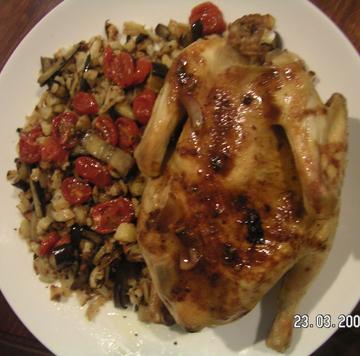Introduction
Creating delicious meals doesn't require an immediate trip to the grocery store. With strategic thinking and culinary flexibility, you can transform virtually any recipe using ingredients already available in your kitchen. This guide provides a systematic approach to recipe adaptation, enabling you to prepare satisfying meals efficiently while minimizing food waste.
Part 1: Inventory Assessment
Step 1: Categorize Your Available Ingredients
Begin by conducting a thorough inventory of your kitchen, organizing ingredients into the following categories:
- Proteins: Meat, poultry, fish, eggs, tofu, legumes, nuts
- Carbohydrates: Rice, pasta, potatoes, quinoa, bread, tortillas
- Vegetables: Fresh, frozen, or canned
- Aromatics: Onions, garlic, ginger, herbs, spices
- Fats: Oils, butter, ghee
- Liquid Components: Broth, stock, wine, vinegar, citrus juices
- Dairy and Alternatives: Milk, cheese, yogurt, plant-based substitutes
Step 2: Analyze Ingredient Shelf Life
Prioritize ingredients with shorter shelf lives to minimize waste:
- Utilize fresh produce before it deteriorates
- Incorporate proteins approaching their expiration dates
- Reserve shelf-stable items for later use
Part 2: Recipe Analysis and Adaptation Principles
Step 3: Identify Core Recipe Components
When adapting a recipe, identify its fundamental elements:
- Primary protein source
- Base carbohydrate or vegetable
- Key flavor profile (Mediterranean, Asian, Latin American, etc.)
- Essential cooking technique (roasting, sautéing, stir-frying, etc.)
Step 4: Apply Substitution Principles
Protein Substitutions
- Direct replacements: Substitute similar proteins (chicken → turkey, beef → lamb)
- Vegetarian transformations: Replace animal proteins with plant-based alternatives (meat → beans, tofu, or tempeh)
- Texture considerations: Match the texture profile of the original protein
Carbohydrate Exchanges
- Similar format substitutions: Replace one grain with another (rice → quinoa, pasta → couscous)
- Alternative bases: Substitute with vegetable-based options (pasta → zucchini noodles, rice → cauliflower rice)
Vegetable Adaptations
- Texture-based substitutions: Replace vegetables with similar textures (bell peppers → zucchini)
- Color preservation: Maintain visual appeal by substituting with similarly colored vegetables
- Cooking method compatibility: Ensure substitute vegetables respond similarly to the required cooking technique
Flavor Profile Maintenance
- Spice and herb replacements: Adjust seasonings while maintaining the recipe's cultural identity
- Acid components: Substitute vinegars or citrus juices to maintain brightness
- Umami elements: Incorporate soy sauce, fish sauce, mushrooms, or tomato paste to enhance depth
Part 3: Practical Adaptation Examples
Example 1: Transforming Chicken Stir-Fry to Vegetarian
Original Recipe Components:
- Protein: Chicken breast
- Vegetables: Broccoli, bell peppers, carrots
- Aromatics: Garlic, ginger, green onions
- Sauce: Soy sauce, rice vinegar, sesame oil
- Base: White rice
Adaptation with Pantry Staples:
- Protein: Extra-firm tofu (pressed and cubed) or canned chickpeas
- Vegetables: Any available vegetables (frozen mixed vegetables work well)
- Aromatics: Onions and dried garlic/ginger if fresh unavailable
- Sauce: Soy sauce with lemon juice if rice vinegar is unavailable
- Base: Any available grain or even ramen noodles without the seasoning packet
Process Adjustments:
- Press and cube tofu, then pre-bake for firmer texture before stir-frying
- Cook frozen vegetables separately to remove excess moisture
- Adjust cooking times based on vegetable density
- Increase aromatics to enhance flavor profile
Example 2: Converting Pasta Bolognese to Pantry-Friendly Version
Original Recipe Components:
- Protein: Ground beef
- Vegetables: Onions, carrots, celery
- Aromatics: Garlic, Italian herbs
- Sauce Base: Tomatoes, red wine
- Carbohydrate: Spaghetti
Adaptation with Pantry Staples:
- Protein: Canned lentils or any ground meat available
- Vegetables: Any available vegetables, finely chopped
- Aromatics: Dried herbs (oregano, basil) if fresh unavailable
- Sauce Base: Canned tomatoes or tomato paste diluted with water
- Carbohydrate: Any pasta shape or even polenta
Process Adjustments:
- Cook lentils until slightly underdone if using canned
- Finely chop available vegetables to mimic traditional soffritto
- Enhance umami with Worcestershire sauce or mushrooms if available
- Extend simmer time with additional liquid if using tomato paste
Part 4: Problem-Solving Strategies for Common Challenges
Addressing Texture Disparities
- Too dry: Add additional liquid (broth, wine, tomato sauce)
- Too wet: Extend cooking time uncovered or add a thickening agent
- Lacking body: Incorporate pureed beans, mashed potatoes, or cornstarch slurry
Balancing Flavor Profiles
- Too bland: Enhance with umami elements (soy sauce, nutritional yeast)
- Too acidic: Balance with sweetness (honey, sugar) or fat (butter, cream)
- Unbalanced spices: Adjust with complementary herbs or finishing elements
Salvaging Problematic Results
- Overcooked proteins: Shred and incorporate into sauces or stews
- Undercooked components: Transform into a different preparation (e.g., frittata)
- Excessive saltiness: Dilute with additional unseasoned ingredients or a touch of acid
Conclusion
Adapting recipes to available ingredients is both a practical skill and a creative opportunity. By understanding fundamental cooking principles and maintaining flexibility, you can produce delicious meals regardless of ingredient limitations. This approach not only solves immediate dinner challenges but also cultivates culinary confidence and reduces food waste.
Remember that successful adaptation relies on understanding the purpose each ingredient serves rather than adhering strictly to the original recipe. With practice, you'll develop the confidence to view recipes as inspirational starting points rather than rigid instructions.





0 Comments